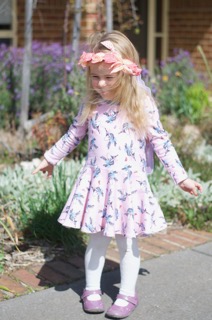
The ‘Jaunty’ Dress by Tahdah patterns
Now that our little Miss is (scarily) hurtling towards being a 4 year old, she is becoming more and more vocal about what she wants to wear. At the moment, it’s all about having big twirly skirts, and tutus. She only has one of each, and they are on high rotation in the washing machine…they are the only things she’ll deign to wear. They often end up being worn to bed, and it’s then a full-on meltdown when I need to get them off her to wash them the next day.
Unicorns, horses and fairies and are all highly coveted, particularly if they are pink, pink, pink! So when I found this French Terry in Spotlight a few months ago, I knew it would be a hit.
This was my first time using French Terry – I don’t think I’ve ever even seen it in Spotlight before. It’s nice and fuzzy/fleecy on the inside, so it feels soft and cosy, and while it’s cotton, I think it had a little elastane (maybe 5%) so it was comfy and stretchy too.
I’m actually not a big unicorn fan, so I can’t say I love this print, but the design on the only other French Terry on offer was really quite weird, so it was the only viable option. The musky pink background combined with the unicorns is quite overly saccharine, but at least it doesn’t have sparkles and glitter all over it. And, in the eyes of my almost-4yo, it’s gorgeous.
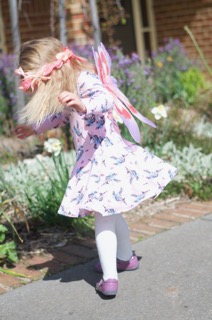
Fairy wings and head garland entirely optional
This pattern is from an Australian indie company, Tadah patterns, that I’ve only just discovered. Evidently, I’m very late to the party, as I realised when I joined their facebook group (TahDah Pattern Party). Thousands of people have used these patterns, and there are some gorgeous and inspiring versions of the designs that people have posted. It’s made me all enthusiastic, and now I have dozens more projects added to my mental to do list. It’s amazing how much time can be spent scrolling through the Facebook feed ooh-ing and ah-ing over all the beautiful dresses people have made! It also has made me purchase quite a lot of the patterns. But that’s OK – as I pointed out to my husband, I love that I’m supporting an Australian business.
I’ve only recently discovered the whole indie pattern thing. I’m not sure how I stumbled onto Tadah Patterns, but I’m so glad I did. I’ve been listening to the British podcast, “Stitchers Brew”, which I’ve been thoroughly enjoying, and it’s made me realise that the whole indie pattern thing is an entire world in itself.
First, you don’t have to drive to a shop to get a pattern! Or wait days on end for the post to arrive if you order a physical one from one of the big 4’s online. Secondly, you can literally buy an indie pattern online, and BAM! the PDF is in your inbox instantly, ready for you to print off and get sewing. Yes, you have to print off a lot of different pages and tape them together, but honestly, its not as bad or as time consuming as I expected.
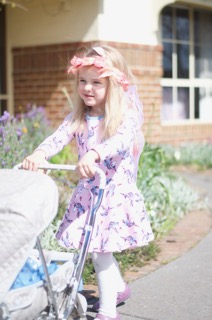
The perfect dress to wear when taking dolly for a walk.
So, this is the “Jaunty Dress” by Tadah patterns. The instructions are super clear and thorough, and the whole dress is very quick to make. I read through the instructions to begin with and then pretty much went ahead and made it without referring to them again. It does recommend using an overlocker for all the seams – I decided to give this a go, and on the whole, it wasn’t as traumatic as I was expecting. The seam allowances are very overlocker-friendly at 6mm, so that helps. And I learnt a new trick – the “overlocker flip method”, which helps give a nice clean and secure finish at the end of the sleeves, something I’ve struggled with in the past. Another revelation was using a rotary cutter instead of scissors to cut out the fabric! Brilliant!

I must admit, this isn’t my best handiwork. I botched one of the seams –the bodice and skirt side seam don’t quite match up, but because it was all overlocked, I wasn’t about to unpick it!. I also managed to make a complete mess of the twin needle topstitching around the neckband. I have NEVER managed to do a good job on this, but this one was so bad, I ended up unpicking it all and calling it quits. If you look closely, you can see where the stitches were, but luckily this is of no concern for its wearer!
In conclusion, this pattern is great – the full circle dropped waist skirt is comfy and flattering over little tadpole tummies, and affords full twirling capacity for all the ballet/fairy/princess moves. It’s comfy and easy to wear, and comes with quite a few sleeve variations (so I’ll be making some more for the warmer weather – if it ever gets here!). The final garment was, thankfully, met with approval by its fussy recipient; after wearing it all day, she insisted on wearing it to bed as well.
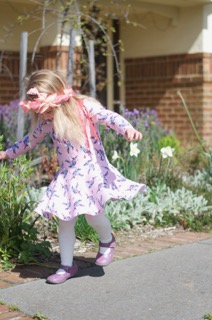
The circle skirt enables full twirlage
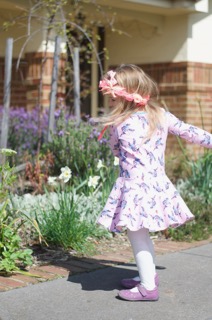
Did I mention it’s good for twirling?
This is a size 4 – I made no adjustments to the pattern aside from doing a slightly smaller hem on the sleeves in order to make them a little longer. I probably should have made a 5 so that it would fit next year too, but I didn’t think of that until after it was all cut out. I suspect there will be many more Jaunty dresses in my life for the next few years!

A very happy customer!









 Anyway, typical of the era, there were no markings on the pattern, just a couple of punch holes that you have to decipher to tell you where the grain of the fabric is etc. And no separate pattern pieces for linings – just a brief sentence or two about how to alter the existing patterns and the assumption that the reader will figure it out.
Anyway, typical of the era, there were no markings on the pattern, just a couple of punch holes that you have to decipher to tell you where the grain of the fabric is etc. And no separate pattern pieces for linings – just a brief sentence or two about how to alter the existing patterns and the assumption that the reader will figure it out.
 Sewing the points of the yoke was a little tricky – trickier than I was anticipating. The finished result isn’t perfect, but luckily, working with such a bulky fabric means that it’s quite forgiving. Still, every time I look at it I wish I had done a better job!
Sewing the points of the yoke was a little tricky – trickier than I was anticipating. The finished result isn’t perfect, but luckily, working with such a bulky fabric means that it’s quite forgiving. Still, every time I look at it I wish I had done a better job!
 The lining is attached by hand to the jacket. I suppose being a child’s jacket, this task didn’t seem too onerous – not sure how I’d feel about doing this in an adult size though!
The lining is attached by hand to the jacket. I suppose being a child’s jacket, this task didn’t seem too onerous – not sure how I’d feel about doing this in an adult size though! I should have given it a bit of a press before taking these photos – it had been sitting on the back seat of our car up when I popped it on her and it’s a little crumpled.
I should have given it a bit of a press before taking these photos – it had been sitting on the back seat of our car up when I popped it on her and it’s a little crumpled.
Warning: Trying to access array offset on value of type bool in /home4/offermag/public_html/vintagenotions/wp-content/themes/liquorice/header.php on line 28
Warning: Trying to access array offset on value of type bool in /home4/offermag/public_html/vintagenotions/wp-content/themes/liquorice/header.php on line 32
Warning: Trying to access array offset on value of type bool in /home4/offermag/public_html/vintagenotions/wp-content/themes/liquorice/header.php on line 36
RSS Feed